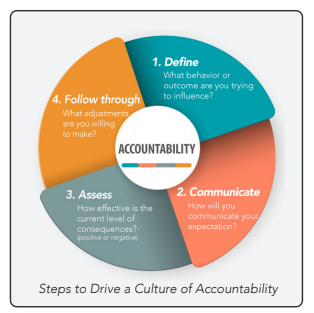
Four Steps to Driving Accountability
Published on November 21, 2019.
If you’ve ever been frustrated or proud of your team or department’s actions, the difference could be related to the level of accountability they are held to. So how do you create a culture of accountability?

Four Steps to Driving Accountability
If you want to create change, influence performance, or drive an action or behavior, establishing accountability is crucial. Greater accountability leads to higher performance, an increased commitment to work, and greater motivation. Think of accountability as the actions you take based on whether someone exceeds, meets, or does not meet expectations. This creates standards for accountability.
Proactively establishing accountability comes down to these four steps:

- Define. Define the behavior or outcome that is needed.
- What is the task, goal, or behavior and why is it important?
- What does success look like?
- When does it need to get done?
- Communicate. A staff or faculty meeting, an email, or during a one-on-one conversation are all great opportunities to communicate expectations.
- Assess. Decide the consequence (positive or negative) when the expectation is or is not met. The consequence can range from social pressure where others will know if the expectation is met, to praise or critique, or even career impact. This model, the Accountability Ladder (see page 3 of the quick guide), illustrates the correlation between your response and the level of accountability.
- Follow through. The follow-through step is arguably the most crucial, and sometimes most difficult within the accountability model. This step requires taking action to address (positively or negatively) about the behavior or outcome. Not taking action can translate to the absence of accountability.
Here’s an example of this model in action.
- Define the Expectation
- All team members are responsible for meeting deadlines for the process improvement project.
- Communicate
- Say: “The process improvement project is our biggest priority for the year. Meeting deadlines along the way will help to ensure that the project is finished on time. To help us stay on track, I’ve outlined all of the key deadlines and I expect everyone to meet them.”
- Assess
- Decide the outcome: Evaluate how well the team met the expectation. How will you reward those who met the expectation? What feedback will you give those who did not?
- Follow through
- Say: “I noticed the extra work you did to ensure you met our deadlines. This helped the team to stay on track. I will make sure to recognize this in your performance review.”
- Or say: “I’ve noticed that you’ve been distracted lately and it’s caused you to miss deadlines, which delayed the rest of the project. What can you do to improve to avoid missing deadlines and how can I help you?”
- If the behavior doesn’t improve, the consequence should increase.
Finally, remember that accountability starts with you. Don’t expect others to meet an expectation that you haven’t met yourself.
Employee Engagement Survey
Thank you for taking the Employee Engagement Survey and encouraging your faculty and staff to do the same.
A record 74% of employees responded to the survey. Faculty increased participation 64%, and our staff response grew to 78%.
Survey results will be available in January 2020. Look for an invitation to the results report from Korn Ferry. Resources to help you share and discuss data with staff and faculty and then take action at the OHR page for Employee Engagement.